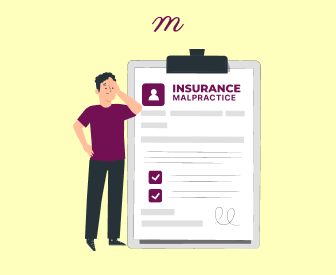Have your progress notes written for you automatically
As a psychotherapist, it is critical to safeguard your practice and reputation as a competent clinician. The goal is always to provide care for your clients, however often times even the most experienced clinician can run into care issues which can lead to legal trouble. Malpractice insurance is a way to keep yourself safe as a clinician as it offers a safety net for you against any lawsuits, legal fees and any damage that could come up from your practice.
This article will give an overview of what malpractice insurance is and help you understand why it is so important to have, insurance options and how to understand the differences of each option.
What is malpractice insurance:
Malpractice insurance is designed to protect clinicians from legal issues related to their professional services. All medical and mental health providers usually have malpractice coverage if they are actively seeing clients or patients. These legal issues can arise from negligence, clinical errors or breaking confidentiality such as violating HIPPA. Malpractice insurance is different than liability insurance as liability only covers physical injuries and property damage. Malpractice insurance covers issues with the care itself, and in mental health care, the damage is very nuanced. It’s important to have this insurance to ensure your practice is safe if you do encounter legal issues (Applebaum, 2021).
Why do Psychotherapist Need Malpractice Insurance:
The relationship between a therapist and their client is nuanced, complex and delicate. It is easy to have misunderstandings or feelings of dissatisfaction as therapy processes take time, building relationships and trust doesn’t happen over night and therapists cannot control the perceptions of what individuals think about therapy. These are known risks to providing psychotherapy. Malpractice insurance is essential for these key reasons:
- Legal protection – Clinicians are vulnerable to lawsuits even if they are practicing professionally. They can still endure claims of negligence, misdiagnoses, treatment issues and breaches of contract.
- Financial protection – Costs for legal defense is very expensive and this insurance offsets the cost and ensures that you are able to afford legal representation without going into debt.
- Professional protection – Most boards of licensure require malpractice insurance if provers are offering services. Many workplaces, for those who are not working for themselves, often also require some kind of malpractice insurance depending on how you are using your credentials (Rosenbaum and Holmberg, 2022).
Types of Malpractice Insurance:
Psychotherapists have different types of malpractice insurance to choose from, and each one has its own pros and cons.
- Claims-made policies only cover you if the claim is filed while the policy is active, so you might need tail coverage to stay protected after the policy ends.
- Occurrence-based policies are different because they cover incidents that happened during the policy period, no matter when the claim is filed. These can be more reassuring but are usually more expensive.
- Tail coverage helps you stay covered after a claims-made policy ends.
- Nose coverage takes care of claims from before your policy started. Individual policies are great for therapists who work alone, while group policies are designed for organizations or practices with multiple therapists, making it easier to fit different practice setups
Malpractice insurance coverage:
When choosing malpractice insurance, it’s important to make sure the policy has the coverage you need to protect you and your private practice. Malpractice coverage is essential because it protects you from claims of negligence, clinical errors and mistakes. Legal defense costs are also crucial, as they cover expenses like attorney fees, court costs, and settlements if you’re taken to court. Coverage for breaches in confidentiality and other patient rights is another important feature to have coverage for as it helps with claims involving unauthorized disclosure of client information. Many practices who use online services may at some point be subject to a hack of a breach of passwords or data. Some policies also include coverage for Good Samaritan acts, which protect you if you help out in emergencies outside of your usual practice or scope, and pro bono work coverage, which applies to services you provide for free. Lastly, it’s a good idea to check the policy’s coverage limits, both per incident and in total, to make sure you’re fully protected.
Malpractice insurance cost:
The cost of malpractice insurance for psychotherapists depends on several factors. Therapists who specialize in high-risk areas, like trauma or substance abuse, usually have to pay higher premiums. Private practitioners often face higher costs compared to those working for organizations that offer group coverage. Location also plays a role, as state regulations and legal climates can affect prices and coverage. Additionally, having a history of past claims can lead to increased premiums, like all insurances. On average, individual psychotherapists pay between $500 and $1,500 per year for coverage, while group policies might provide discounts for practices with multiple therapists (Zaki, et al., 2021).
How to choose the right insurance provider:
Choosing the right malpractice insurance provider is just as important as picking the right policy. It’s a good idea to go with a provider that has a solid reputation and financial stability to make sure they can back you up when needed. Look for providers that offer features you can customize to fit your specific practice needs as not all offer an a-la-carte menu of coverage items. The claims process is another big factor—make sure it’s simple and supportive in case you ever need to file a claim. Research reviews and ask for recommendations from colleagues or professional associations to find a provider you can trust. It’s important to find a provider that is vetted and understand you want a provider that will help you stay in business and protect your license and yourself in legal situations.
How to get malpractice insurance:
Getting malpractice insurance is a pretty straightforward process but it’s important to take your time and be diligent in your process. Research different providers to compare their options and what they offer. Make sure you understand your state’s licensing board and professional association requirements so you know what you need. Request detailed quotes from multiple providers to compare costs and coverage. Take your time reviewing the policies, especially the exclusions, limits, and any extra coverage options they might include. Once you’ve found the right fit, complete the application and provide any necessary documentation to get covered. It’s important to take the time to consider the specific needs of your practice and think about your professional goals, if you plan to insurance additional types of services or offer online therapy, and if all the services you offer are covered.
Common risks:
Practicing without malpractice insurance puts you at serious financial and professional risk, as you would be personally responsible for any legal costs and damages that may be incurred. While the requirement for malpractice insurance varies by state and employer, it’s strongly recommended even if it's not mandatory. Employer-provided insurance might not fully cover you outside of work hours or for independent practice, so it’s important to verify the details of the policy. Part-time therapists may be eligible for lower premiums, as many insurers offer reduced rates for those working fewer hours, but be sure to disclose your working hours when applying for coverage.
Managing risks:
Reducing the chances of encountering legal issues is important for protecting both your clients and yourself. One way is to keep thorough documentation because detailed and accurate records can be vital if you ever need to defend against a claim. These are important to keep as they can also be subpoenaed. It’s also important to follow professional standards by sticking to ethical guidelines and staying updated on best practices. Attending training and workshops regularly can help you improve your skills and stay sharp. Most continuing education credits for therapists include ethics as a requirement.
Clear communication with clients is another big factor, especially when it comes to setting expectations and using informed consent forms, so having standard forms for all clients is important. Lastly, seeking supervision by consulting with colleagues or supervisors can provide valuable guidance for handling tough cases and ensures you’re avoiding practicing with a bias by reviewing cases with others (Walker, et al., 2020).
Malpractice insurance is an essential part of a psychotherapist’s professional toolkit. It offers peace of mind, financial protection, and the confidence to focus on delivering high-quality care. By understanding your options and choosing the right policy, you can make sure your practice is protected from unexpected challenges. Take the time to assess your needs, research different providers, and select coverage that fits with your goals. Your future self will definitely appreciate it.
References
Appelbaum, P. S. (2021). Malpractice claims in psychiatry: approaches to reducing risk. World Psychiatry, 20(3), 438.
Rosenbaum, K. B., & Holmberg, T. C. (2022). Negligent Psychotherapy. In Malpractice and Liability in Psychiatry (pp. 137-143). Cham: Springer International Publishing.
Walker, L. E., Shapiro, D., Akl, S., Walker, L. E., Shapiro, D., & Akl, S. (2020). Malpractice and Risk Management. Introduction to Forensic Psychology: Clinical and Social Psychological Perspectives, 365-373.
Zaki, M., LaSala, R., Saltmarsh, D., Gern, A., & Eloy, J. A. (2021). Understanding Your Malpractice Insurance Policy. Litigation in Otolaryngology: Minimizing Liability and Preventing Adverse Outcomes, 51-57.










